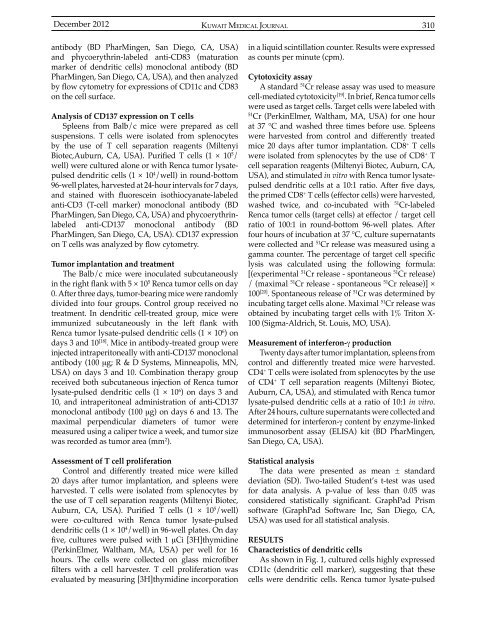Vol 44 # 4 December 2012 - Kma.org.kw
Vol 44 # 4 December 2012 - Kma.org.kw
Vol 44 # 4 December 2012 - Kma.org.kw
You also want an ePaper? Increase the reach of your titles
YUMPU automatically turns print PDFs into web optimized ePapers that Google loves.
<strong>December</strong> <strong>2012</strong><br />
KUWAIT MEDICAL JOURNAL 310<br />
antibody (BD PharMingen, San Diego, CA, USA)<br />
and phycoerythrin-labeled anti-CD83 (maturation<br />
marker of dendritic cells) monoclonal antibody (BD<br />
PharMingen, San Diego, CA, USA), and then analyzed<br />
by flow cytometry for expressions of CD11c and CD83<br />
on the cell surface.<br />
Analysis of CD137 expression on T cells<br />
Spleens from Balb/c mice were prepared as cell<br />
suspensions. T cells were isolated from splenocytes<br />
by the use of T cell separation reagents (Miltenyi<br />
Biotec,Auburn, CA, USA). Purified T cells (1 × 10 5 /<br />
well) were cultured alone or with Renca tumor lysatepulsed<br />
dendritic cells (1 × 10 4 /well) in round-bottom<br />
96-well plates, harvested at 24-hour intervals for 7 days,<br />
and stained with fluorescein isothiocyanate-labeled<br />
anti-CD3 (T-cell marker) monoclonal antibody (BD<br />
PharMingen, San Diego, CA, USA) and phycoerythrinlabeled<br />
anti-CD137 monoclonal antibody (BD<br />
PharMingen, San Diego, CA, USA). CD137 expression<br />
on T cells was analyzed by flow cytometry.<br />
Tumor implantation and treatment<br />
The Balb/c mice were inoculated subcutaneously<br />
in the right flank with 5 × 10 5 Renca tumor cells on day<br />
0. After three days, tumor-bearing mice were randomly<br />
divided into four groups. Control group received no<br />
treatment. In dendritic cell-treated group, mice were<br />
immunized subcutaneously in the left flank with<br />
Renca tumor lysate-pulsed dendritic cells (1 × 10 6 ) on<br />
days 3 and 10 [18] . Mice in antibody-treated group were<br />
injected intraperitoneally with anti-CD137 monoclonal<br />
antibody (100 μg; R & D Systems, Minneapolis, MN,<br />
USA) on days 3 and 10. Combination therapy group<br />
received both subcutaneous injection of Renca tumor<br />
lysate-pulsed dendritic cells (1 × 10 6 ) on days 3 and<br />
10, and intraperitoneal administration of anti-CD137<br />
monoclonal antibody (100 μg) on days 6 and 13. The<br />
maximal perpendicular diameters of tumor were<br />
measured using a caliper twice a week, and tumor size<br />
was recorded as tumor area (mm 2 ).<br />
Assessment of T cell proliferation<br />
Control and differently treated mice were killed<br />
20 days after tumor implantation, and spleens were<br />
harvested. T cells were isolated from splenocytes by<br />
the use of T cell separation reagents (Miltenyi Biotec,<br />
Auburn, CA, USA). Purified T cells (1 × 10 5 /well)<br />
were co-cultured with Renca tumor lysate-pulsed<br />
dendritic cells (1 × 10 4 /well) in 96-well plates. On day<br />
five, cultures were pulsed with 1 μCi [3H]thymidine<br />
(PerkinElmer, Waltham, MA, USA) per well for 16<br />
hours. The cells were collected on glass microfiber<br />
filters with a cell harvester. T cell proliferation was<br />
evaluated by measuring [3H]thymidine incorporation<br />
in a liquid scintillation counter. Results were expressed<br />
as counts per minute (cpm).<br />
Cytotoxicity assay<br />
A standard 51 Cr release assay was used to measure<br />
cell-mediated cytotoxicity [19] . In brief, Renca tumor cells<br />
were used as target cells. Target cells were labeled with<br />
51<br />
Cr (PerkinElmer, Waltham, MA, USA) for one hour<br />
at 37 °C and washed three times before use. Spleens<br />
were harvested from control and differently treated<br />
mice 20 days after tumor implantation. CD8 + T cells<br />
were isolated from splenocytes by the use of CD8 + T<br />
cell separation reagents (Miltenyi Biotec, Auburn, CA,<br />
USA), and stimulated in vitro with Renca tumor lysatepulsed<br />
dendritic cells at a 10:1 ratio. After five days,<br />
the primed CD8 + T cells (effector cells) were harvested,<br />
washed twice, and co-incubated with 51 Cr-labeled<br />
Renca tumor cells (target cells) at effector / target cell<br />
ratio of 100:1 in round-bottom 96-well plates. After<br />
four hours of incubation at 37 °C, culture supernatants<br />
were collected and 51 Cr release was measured using a<br />
gamma counter. The percentage of target cell specific<br />
lysis was calculated using the following formula:<br />
[(experimental 51 Cr release - spontaneous 51 Cr release)<br />
/ (maximal 51 Cr release - spontaneous 51 Cr release)] ×<br />
100 [20] . Spontaneous release of 51 Cr was determined by<br />
incubating target cells alone. Maximal 51 Cr release was<br />
obtained by incubating target cells with 1% Triton X-<br />
100 (Sigma-Aldrich, St. Louis, MO, USA).<br />
Measurement of interferon-γ production<br />
Twenty days after tumor implantation, spleens from<br />
control and differently treated mice were harvested.<br />
CD4 + T cells were isolated from splenocytes by the use<br />
of CD4 + T cell separation reagents (Miltenyi Biotec,<br />
Auburn, CA, USA), and stimulated with Renca tumor<br />
lysate-pulsed dendritic cells at a ratio of 10:1 in vitro.<br />
After 24 hours, culture supernatants were collected and<br />
determined for interferon-γ content by enzyme-linked<br />
immunosorbent assay (ELISA) kit (BD PharMingen,<br />
San Diego, CA, USA).<br />
Statistical analysis<br />
The data were presented as mean ± standard<br />
deviation (SD). Two-tailed Student’s t-test was used<br />
for data analysis. A p-value of less than 0.05 was<br />
considered statistically significant. GraphPad Prism<br />
software (GraphPad Software Inc, San Diego, CA,<br />
USA) was used for all statistical analysis.<br />
RESULTS<br />
Characteristics of dendritic cells<br />
As shown in Fig. 1, cultured cells highly expressed<br />
CD11c (dendritic cell marker), suggesting that these<br />
cells were dendritic cells. Renca tumor lysate-pulsed
















